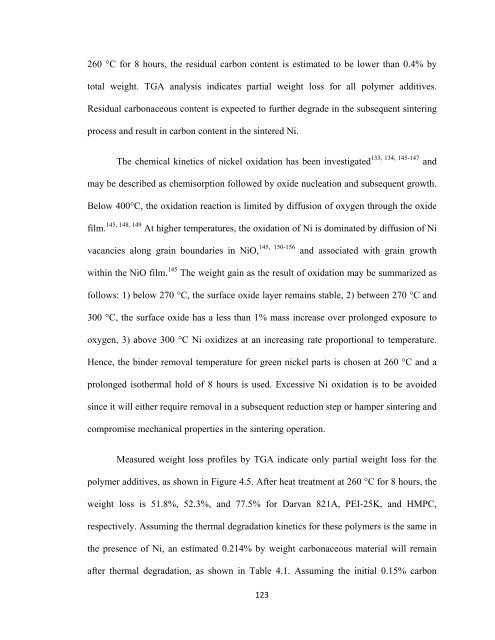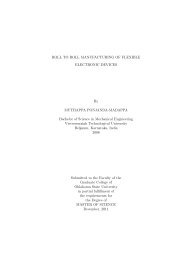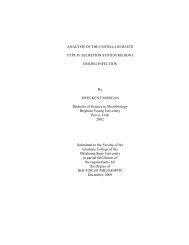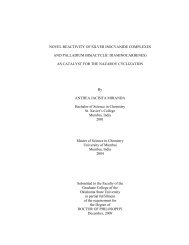DESIGN, ASSEMBLY AND CHARACTERIZATION OF COMPOSITE ...
DESIGN, ASSEMBLY AND CHARACTERIZATION OF COMPOSITE ...
DESIGN, ASSEMBLY AND CHARACTERIZATION OF COMPOSITE ...
Create successful ePaper yourself
Turn your PDF publications into a flip-book with our unique Google optimized e-Paper software.
260 °C for 8 hours, the residual carbon content is estimated to be lower than 0.4% by<br />
total weight. TGA analysis indicates partial weight loss for all polymer additives.<br />
Residual carbonaceous content is expected to further degrade in the subsequent sintering<br />
process and result in carbon content in the sintered Ni.<br />
The chemical kinetics of nickel oxidation has been investigated 133, 134, 145-147 and<br />
may be described as chemisorption followed by oxide nucleation and subsequent growth.<br />
Below 400°C, the oxidation reaction is limited by diffusion of oxygen through the oxide<br />
film. 145, 148, 149 At higher temperatures, the oxidation of Ni is dominated by diffusion of Ni<br />
vacancies along grain boundaries in NiO, 145, 150-156 and associated with grain growth<br />
within the NiO film. 145 The weight gain as the result of oxidation may be summarized as<br />
follows: 1) below 270 °C, the surface oxide layer remains stable, 2) between 270 °C and<br />
300 °C, the surface oxide has a less than 1% mass increase over prolonged exposure to<br />
oxygen, 3) above 300 °C Ni oxidizes at an increasing rate proportional to temperature.<br />
Hence, the binder removal temperature for green nickel parts is chosen at 260 °C and a<br />
prolonged isothermal hold of 8 hours is used. Excessive Ni oxidation is to be avoided<br />
since it will either require removal in a subsequent reduction step or hamper sintering and<br />
compromise mechanical properties in the sintering operation.<br />
Measured weight loss profiles by TGA indicate only partial weight loss for the<br />
polymer additives, as shown in Figure 4.5. After heat treatment at 260 °C for 8 hours, the<br />
weight loss is 51.8%, 52.3%, and 77.5% for Darvan 821A, PEI-25K, and HMPC,<br />
respectively. Assuming the thermal degradation kinetics for these polymers is the same in<br />
the presence of Ni, an estimated 0.214% by weight carbonaceous material will remain<br />
after thermal degradation, as shown in Table 4.1. Assuming the initial 0.15% carbon<br />
123





